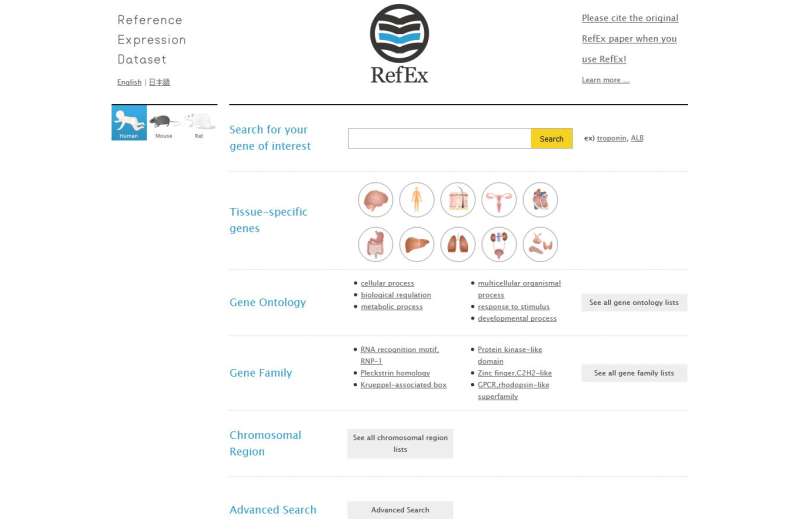RefEx, a web tool for a comfortable search of reference data for gene expression analysis

Currently, there are many public databases available to everyone in the field of life science, but there are many problems when you try to use them, namely you do not know which to use, how to use and even where to find a necessary one. Especially gene expression data has a complex situation, since there are several measurement methods developed by different research groups and the data accumulated exponentially for the sake of the invention of DNA microarray, which measures the gene expression level not only for the genes of interest but also genome wide area. Researchers need to find a representative gene expression level data set or reference data to start their experiment, but are faced with a bewildering amount of gene expression data.
A group of researchers from Database Center for Life Science (DBCLS) and National Institute of Genetics (both in the Research Organization of Information and Systems) has developed a web tool RefEx that makes it easy to search and view the gene expression levels of each gene to find a reference for gene expression analysis.
RefEx contains the data from three kinds of organisms, human, mouse, and rat, obtained from normal tissues and cell lines (556 tissues/cell lines in total) measured by four different methods (EST, GeneChip, CAGE and RNA-seq). All data are acquired from public databases including those from the FANTOM5 project. When more public expression data become available, RefEx will incorporate them and become more useful and accurate.
Along with the extensive collection of gene expression data, RefEx enables the comparison of the gene expression status in each tissue/cell with the difference among the measurement methods. You can search the data for certain group of genes simply by gene name, or gene ontology and family name. Furthermore, you can select "tissue/cell-specific genes", namely marker genes representing characteristics of the tissue/cell calculated by applying a uniform method to all the accumulated public data by clicking tissue icons in RefEx top page.
The search/select result shows the comparison of the relative expression levels among tissues and among the four measurement methods, and the relative expression amount is reflected as a heat-map in the 3D model of the human body. You can also compare annotation information (Gene Ontology, etc.) on functions assigned to genes in the search results. These functions support new knowledge discoveries and hypothesis buildings.
Using RefEx, researchers can confirm the expression level of the genes of interest in many tissues or cells under normal condition, without bench-top experiments. It is also useful as a tool to know the relationship of genes found in functional analysis to elucidate biological phenomena and interpret research results leading to the development of medicines etc. Thus RefEx is expected to contribute to a wide variety of life science and medical research as a powerful web tool for gene expression analysis.
More information: Hiromasa Ono et al, RefEx, a reference gene expression dataset as a web tool for the functional analysis of genes, Scientific Data (2017). DOI: 10.1038/sdata.2017.105


















